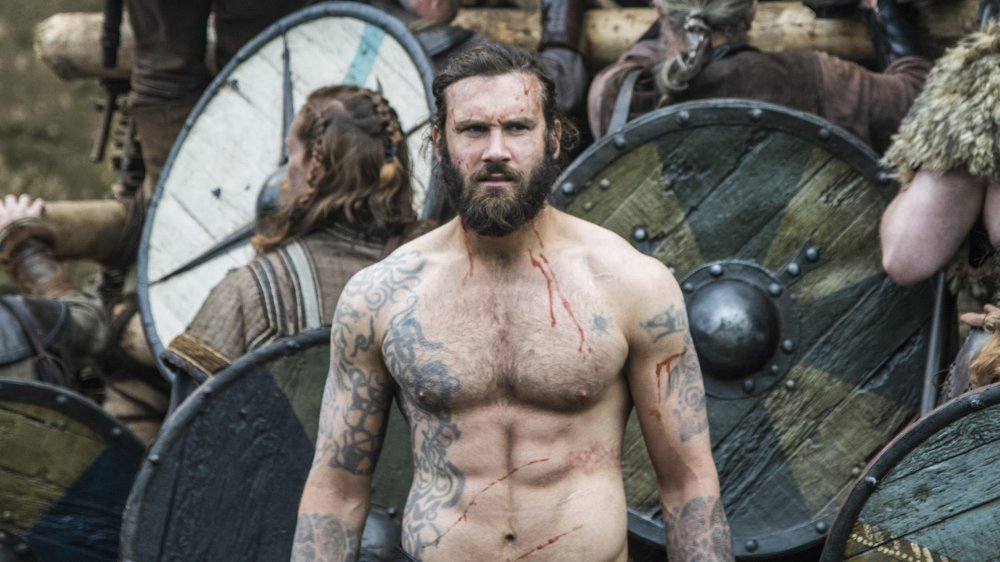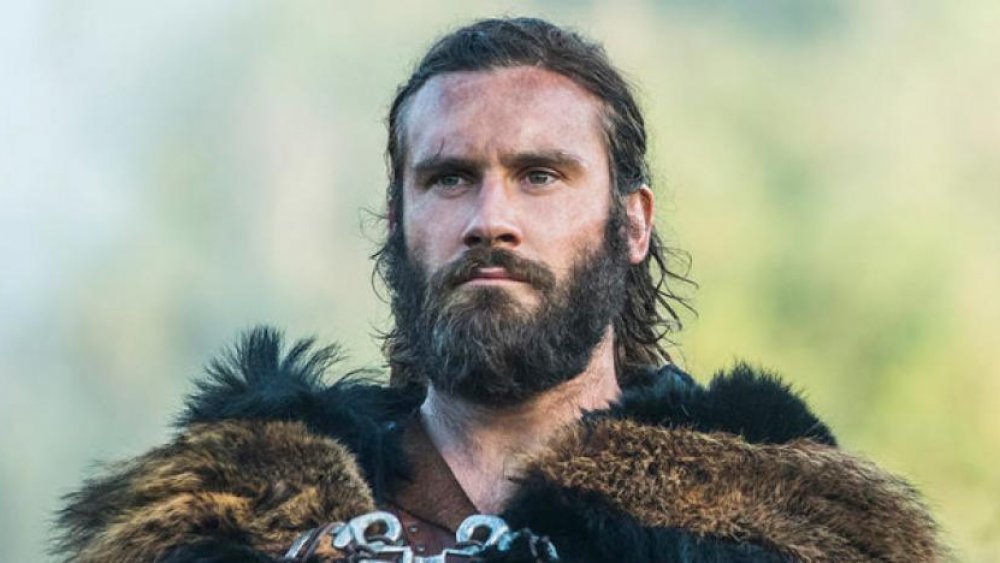The Real Meaning Behind Rollo's Tattoos On Vikings
History Channel's hit drama Vikings features all its characters festooned in tattoos to play up their ancient tribal nature — though the actual history can't say for sure if that was a cultural truth. Historical accuracy is always slippery for television dramas, and on top of that, the records pertaining to the Viking people as they lived are all from third parties (they kept no written records of their own), so the series gives and takes from what little fact exists as it pleases. For instance, Rollo Sigurdsson, Ragnar Lothbrok's brother, is loosely based on a man that lived at the end of the ninth century and did indeed abandon his Nordic roots to become the first Duke of Normandy. Rollo does exactly this on Vikings – though the real-life man almost certainly wasn't at the actual sacking of Paris as depicted on the show and was definitely not related to Ragnar, who can't be proven to ever have existed at all outside the written epics in which he's featured.
Whether or not the Viking people were tatted up like the characters on the History Channel show, some of the skin ink shown on the series represents important aspects of the Viking mythology. In particular, on Vikings, Rollo (played by Clive Standen) has several elaborate tattoo designs of his own. Accompanying all the characteristic weaving knot structures across his torso is a pair of wolves on his arm. The gentle wave of enthusiasm for Norse mythology that drifts in the wake of the success of media like Vikings (and everything attached to Thor in the Marvel Cinematic Universe) has rekindled some popular interest, but Rollo's wolf tattoos in particular represent a deeper cut of Viking folklore than most.
Here's the real meaning behind Rollo's tattoos on Vikings.
Rollo's wolf tattoos symbolize a cyclical harbinger of doom
The two wolves Rollo has tattooed are brothers born of the great wolf Fenrir. In Norse mythology, the twin wolves Hati and Skoll — names that loosely translate to "hate" and "mockery" in English — were, in most versions of the tale, the sons of Fenrir and a werewolf mother. Being a creature of darkness and a son of Loki, Fenrir is eventually imprisoned in magical chains by Odin and the rest of the divine pantheon until the Norse interpretation of the apocalypse, Ragnarok. His wolf sons are enraged by the act, and, after failing to free him, begin chasing the astrological avatars of the sun and moon — the siblings Sol and Mani. As in many creationist myths, the brother-sister duo pull the celestial bodies around the world in perpetuity. Fenrir is meant to consume Odin when chaos reasserts itself and Ragnarok arrives, so his sons Hati and Skoll are destined to eventually catch and eat Sol and Mani to plunge the universe back into the darkness from whence it emerged.
In a 2014 video shot for History's YouTube Channel, Vikings makeup department head Tom McInerney and Rollo actor Clive Standen spoke about the character's tattoos. While McInerney initally joked that he had no idea what Rollo's tats meant — and that the makeup team just slapped a bunch on his skin for no reason — Standen interjected with a laugh to explain that "Rollo" means "famous wolf," which factors into the wolf tattoos he has.
McInerney piggybacked off that comment to detail, "We have two wolves in Norse mythology, chasing the moon and the sun. [...] One eating the sun and one devouring the moon." It was only a matter of seconds before the makeup department head was cracking jokes again, teasing that Standen was "so adamant that he wanted to get his shirt off all the time."
It's fitting for Rollo in particular to bear tattoos with such a history. He's the one who initially suggests the raids that make him and his brother famous — which is a particularly dark omen for history right off the cuff — and arrives on English shores to consume as he wills. Along with that effective historical characterization, the tattoos of Hati and Skoll that Rollo rocks is fitting for the place he has in his relationship to his family and the rest of his clan: He's separated from them by bitterness that eventually blooms into hatred, and acts out against them by joining their enemies.
This all goes to show that even the smallest touches can be thought out by a costume or art designer to give flavor and depth that only the most devoted audience would seek to learn.

